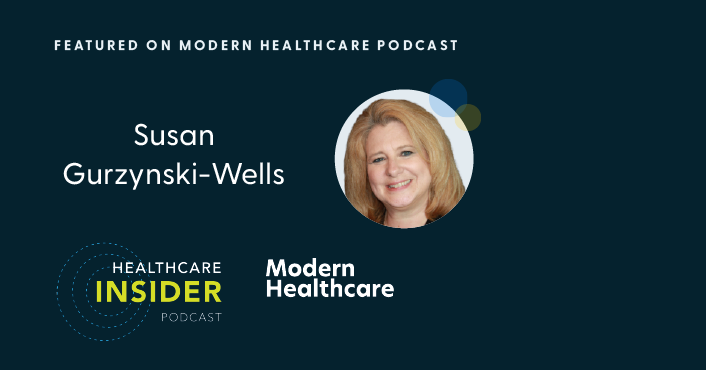






Healthcare Insider Podcast: Fusing AI and human touch in revenue cycle management

Automation and artificial intelligence can help healthcare organizations navigate staffing shortages while maximizing financial outcomes - but only if personnel are trained and skilled appropriately.
This blog post is taken from a recent Healthcare Insider podcast featuring Susan Gurzynski-Wells, MS, RHIA, director of product management at HealthStream, who discusses opportunities for AI and Automation to be leveraged in revenue cycle management and explores strategies for ensuring the workforce is prepared to use these technologies most effectively. Gurzynski-Wells is a subject matter expert in the areas of ICD-10 and CPT coding, evaluation, and management, as well as patient access and revenue cycle management. She regularly works with clients to align revenue cycle solutions with both clinical and business objectives.
Susan was inspired to get into healthcare by her father, who was the head of the Department of Public Assistance in Pennsylvania. He had worked on a project to eliminate fear of payment from patient care, which opened up her knowledge of hospitals and healthcare. This long exposure to the needs of various stakeholders in healthcare, and particularly the revenue cycle management aspect of healthcare, has provided insight into the current urgency to address automation in revenue cycle management.
"I think given our current and potentially future staffing shortages, organizations are going to need to leverage automation for routine tasks. That automation can speed up processes, enhance accuracy, and free up our revenue cycle staff to focus on the tasks that require critical thinking and human intervention, thereby giving more attention to those complex claims," Gurzynski-Wells explained.
She acknowledges the task of operationalizing AI in revenue cycle management can be daunting, but advises organizations to remember, "Automation is not a substitute for effective revenue cycle process design … Automation and AI can enhance efficiency. It can identify trends and it could even cut costs, but it's important to note there isn't a one-size-fits-all."
The balance of automation against staff intervention and monitoring to catch errors or anomalies is essential to success. For this reason, Gurzynski-Wells says it is important to "build a talent base" that understands this.
This begins with understanding and documenting your current processes prior to implementing any automation or AI tools. It is a big transition, and to get the most out of it, organizations need to have a firm grasp on what they are currently doing so they are prepared to adapt to new technologies. Gurzynski-Wells says that "overreliance" on technologies may introduce new risks or negative outcomes. "These technologies really require that continuous monitoring, [because] they can produce errors that require human intervention to identify and resolve. And I think those skills may be new to some of our current revenue cycle staff. Data analytics is essential in monitoring output and then identifying those risks and trends. So specialty proficiency and things like analytics, cybersecurity, and denials management can be beneficial in optimizing those tools and resources that are available with the new technologies."
Of course, competency in problem-solving and social skills will also be critical, because staff will be working with anomalies or special cases that will require a little detective work and interaction with the patient or guarantors to resolve any issues. As an example, Gurzynski-Wells mentioned her dad, who is now "that 89-year-old who is seeking healthcare and has some special needs when it comes to understanding the technologies."
She goes on to say that the time is now to bring in the next generation of revenue cycle management professionals to build their skills and participate in training opportunities that incorporate these new technologies from the start. This will also give them opportunities to develop their own areas of specialty expertise, potentially growing their careers. In terms of Gen Z workers, Gurzynski-Wells explains, "They're more comfortable working in organizations that utilize advanced technologies more so than the generations that preceded them. They also embrace opportunities to take on new responsibilities, to continue their professional development and career growth. So I think organizations can motivate this younger generation by capitalizing on their skills, supporting the new technologies, soliciting input on the process design and monitoring, and providing paid opportunities for certification and continuing education." She noted the certifications and options for continuing education offered through HealthStream that are perfect learning opportunities such as Clinical Documentation, Insurance & Billing, and Denials Management, to name a few.
The bottom line: Organizations can't implement these new technologies and assume that they will be integrated in a way that is efficient but also patient-centric. There will be a learning curve for staff as well as patients, but organizations will need to rely on staff to ensure a smooth transition. "Automation should not be a substitute for human engagement," Gurzynski-Wells warns, adding, "I think leveraging technology's potential under human review is of utmost importance. Having a clear picture of the current state in addition to where the technologies can take us, and then allowing our staff to continue to develop their skills while mastering the new technologies is going to go a long way in minimizing the disruption and then maximizing the financial outcomes for the organizations that have adopted AI and automation."
During this interview, Gurzynski-Wells shares critical insights about operationalizing AI in revenue cycle management, ensuring the smooth integration of new tools, and helping the next generation of professionals achieve their career goals.
You can listen to the full episode here.
If you'd like to learn more about HealthStream's Revenue Cycle Management, click here.
